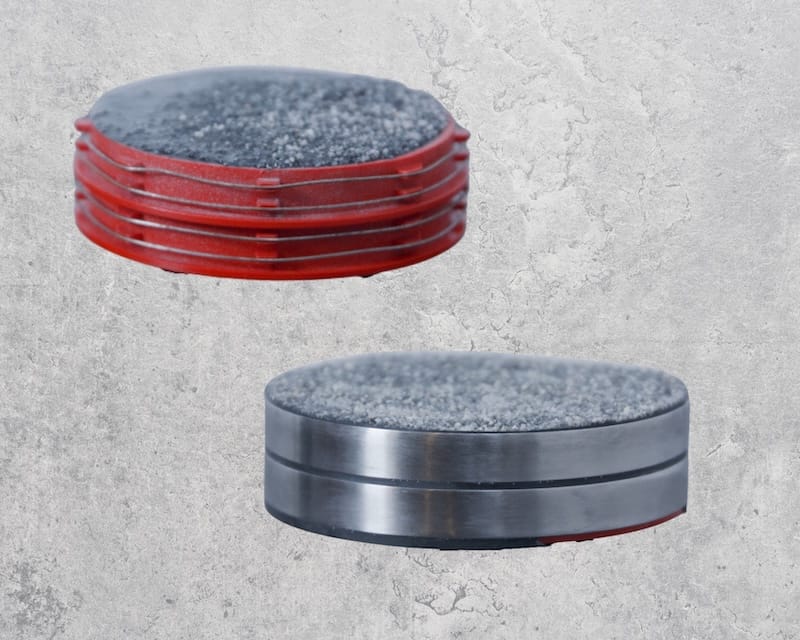MONITORING OF THE SOUTH BRIDGE IN KOBLENZ
The realisation of a digital, sensor-based and proactive online monitoring (IoT) of corrosion and moisture events of a bridge structure in the course of refurbishment.
Monitoring of the concrete bridge section of the southern tangent with the help of innovative sensors
The construction of a generously dimensioned southern tangent in Koblenz, which crosses the Hunsrückhöhenstraße (B327) with the Südbrücke, was intended to solve a pressing traffic problem for the city in 1972.
The solution for long-distance traffic, but also for local and inner-city traffic, was the construction of the “Koblenz southern tangent,” as the Rhineland-Palatinate road administration gave its project name. This has now been rehabilitated in large parts.
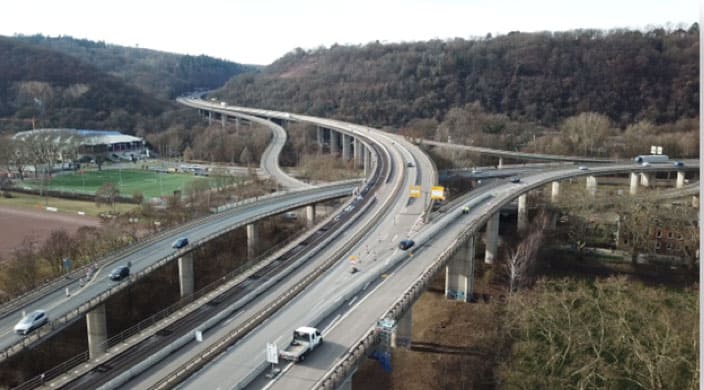
Facts & figures
- Construction of the structures: 1972 to 1975
- Construction area: approx. 93,000 m²
- Traffic load: approx. 45,489 vehicles/24h, heavy goods traffic share of 3%.
Repair measure
The entire road surface, the waterproofing underneath, the existing crash barriers and railings, the structure caps and the drainage facilities will be demolished entirely and renewed.
All concrete surfaces of the structures will also be repaired. This also applies to the concrete surfaces of the bridge soffit and the walkable bridge hollow bodies (superstructures). For this purpose, all concrete surfaces are examined by means of tapping or a potential field measurement and damaged areas in the concrete are repaired locally. In total, this involves approx. 136,500 m² of the concrete surface to be examined.
Based on the potential field plans, a warning system was designed and implemented by BS2 Safety Systems to monitor the corrosion status and moisture development at defined points of the bridge concrete. In addition, the temperature is used as a calculation factor for the concrete moisture, which is also measured. For this purpose, a bridge section was selected in coordination with LBM and made available to BS2.
- The basis for this solution is the use of new energy-less moisture sensors and point corrosion sensors with a service life of several decades.
- These sensors are wire- and energy-free and correspond in technical design to the service life of a bridge.
- The sensors provide clear output values that enable the LBM to draw appropriate conclusions for further action in the event of deviations from the target value, aiming to proactively identify future damage and increase the structure's durability and sustainability.
- Experiences from bridge projects at home and abroad, as well as from the "duraBAst" project, are to be taken into account.
- The entire monitoring system is to be operated in a way that is suitable for construction sites, simple and without additional effort with online data readout.
- The antennas of the sensors are to be installed and switched to 7 communication points/gateways (4 pieces/gateway) in order to realise an online readout for the purpose of web-based and location-independent readout without having to go to/inside the building.

Representation of the location and the sensor antenna
Main application
Areas with the highest potential: 11 units “F
Bridge drains: 9 “F” units
FÜK: 2 units “F
Total sensors
24 pcs “F4″ and pcs “K”

Installation of the sensors
All sensors are designed with remote antennae. The remote antennas are all installed in the bridge box. The sensors were installed after the new concrete was poured and before the bitumen sealing was applied. Therefore, the sensors were installed by drilling a core hole (approx. 4cm deep) and coupling mortar (BS2).
The connections of the remote antennas are led through a hole down into the bridge box. Since many sensors are installed in the area outside the bridge box, the cable is laid above in a cut channel approx. 1cm deep, up to the desired point of the hole in the bridge box.
The holes were sealed with Hilti Hit (epoxy resin mortar) after the cable had been fed through (above and below). The sensor and antenna were made separately and are only connected to each other in the bridge box.
The sensor and cable were sealed flush with the surface after installation.
BAST-listed building materials were used as concrete substitutes.
The processed areas were pre-treated, and then these areas were coated with a 2-component epoxy primer (VEDAPONT EP/N).
This coating was applied before the entire surface was prepared for further waterproofing. The entire surface was then coated with the epoxy primer (Schnorpfeil).
Installation of the gateway
All sensors are designed with remote antennas. The remote antennas are all installed in the bridge box. The sensors were installed after the new concrete was poured and before the bitumen sealing was applied. Therefore, the sensors were installed by drilling a core hole (approx. 4cm deep) and coupling mortar (BS2).
The remote antenna connections are led through a hole down into the bridge box. Since many sensors are installed in the area outside the bridge box, the cable is laid above in a cut channel approx. 1cm deep, up to the desired point of the hole in the bridge box.
The holes were sealed with Hilti Hit (epoxy resin mortar) after the cable had been fed through (above and below). The sensor and antenna were made separately and are only connected to each other in the bridge box.
The sensor and cable were sealed flush with the surface after installation.
BAST-listed building materials were used as concrete substitutes.
The processed areas were pre-treated, and then these areas were coated with a 2-component epoxy primer (VEDAPONT EP/N).
This coating was applied before the entire surface was prepared for further waterproofing. Afterwards, the entire surface was coated with the epoxy primer (Schnorpfeil).
The 28 sensor antennas were distributed to 7 communication points (4 sensor antennas/gateway each). In addition, a reset button and an LED button were installed, which only served to display the output voltage of the power supply unit.
Four antennas each were glued into the cover (inside) of the gateway opposite the interrogation coils. Mounting glue was used for this. Then, the cables are led through cable inlets to the outside, where they are connected to the connection cables of the sensors in the bridge box by means of IP67 connection sleeves.
The configuration of the sensors with the communication points / online gateways was carried out on-site. The system was then put into operation. The IoT sim cards are from Deutsche Telekom and comply with the latest 5G/NB-IoT standard, which enables extremely cost-effective data operation and good reception in structures.
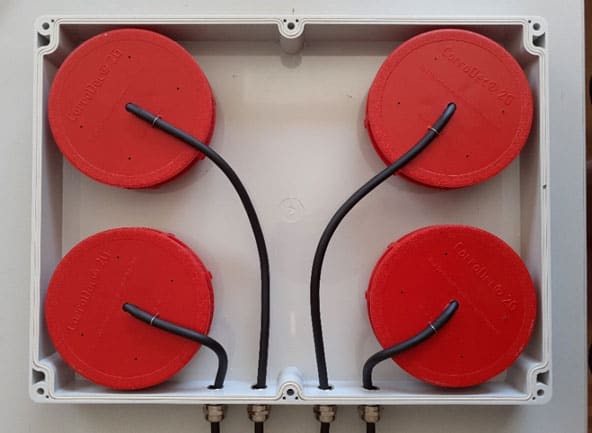

Presentation of the results
For humidity sensors
The moisture condition, in combination with external chemical influences, is crucial for the formation of corrosion processes. Optimal when the moisture curve remains low and constant over a long period of time. Critical for the concrete if the moisture curve is exposed to large fluctuations over a long period of time. Among other things, this can be due to leakage through cracks on the surface. If such deviations are detected at an early stage, damage can be significantly limited/minimised.
The data evaluation of all installed moisture sensors showed an intact behaviour so far. As can be seen from the diagrams, the delivered and evaluated data of the moisture sensors show that the concrete environment dries out regularly, and so far, no signs of unusual moisture fluctuations are visible. This indicates a dense and intact surface and seal.
For corrosion sensors
In the data evaluation of the four corrosion sensors, the corrosion sensor with the ID: 1454 showed a corrosion leg influence in the first plane. The moisture sensors in the vicinity show extremely low moisture values. The following conclusion is obvious:
It is known that this sensor was installed in the area of highly elevated residual chloride levels (see circle mark). It is also obvious that the increased moisture content had occurred in this area before the final coating and that corrosive reactions had taken place in it.
The underlying wire level is intact, and all installed moisture sensors in the vicinity currently show a usual low moisture value. In the future, this area should be monitored more closely. All other sensors show intact behaviour
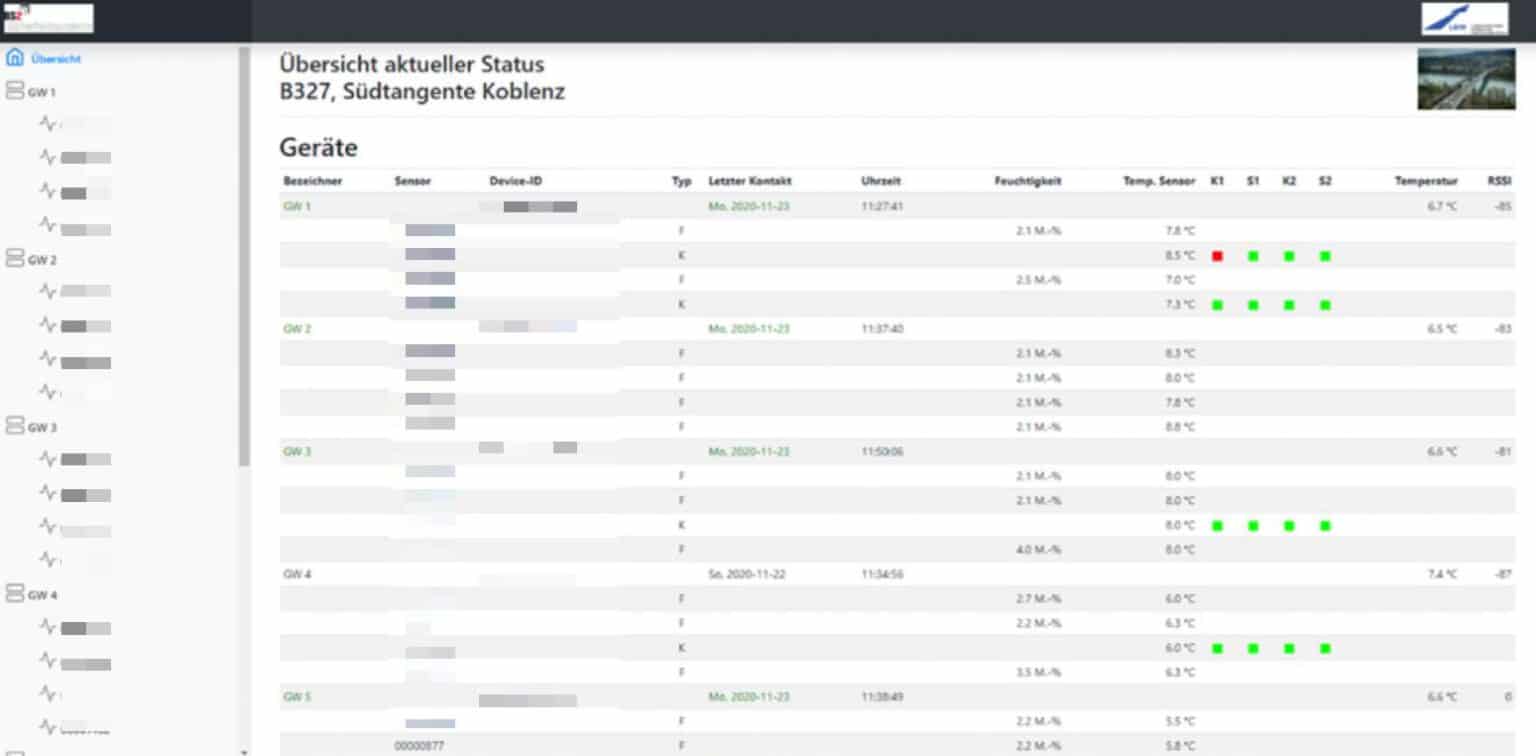

The concrete’s level and type of moisture are essential parameters in the corrosion process of the reinforcement. Once corrosion has started on the reinforcement, the rate of corrosion is highly influenced by the type and level of moisture. The monitoring system was designed and installed here to provide external visibility by transmitting these key building physics data online.
A prewarning sensor system for monitoring corrosion behaviour and moisture in the concrete was successfully installed on a section of the Südtangente bridge in Koblenz. The data is read out with the help of a gateway and transmitted to the BS2 cloud via IoT connectivity. There, they are evaluated and made available to LBM Online. The meaningful observation is possible when measurement data is evaluated over a longer period of time. Since the assessment of moisture in concrete depends on numerous influencing factors, concrete experts should be consulted when assessing the course of moisture values. The monitoring system is a non-destructive method for rapid data acquisition under concrete construction conditions.
Realised goals
- Contribution to the digitalisation and testing of innovative technologies
- Contribution to the durability/sustainability of the structure
- Proactive/online visibility of early warning parameters
Our solutions for monitoring the A8 motorway bridge
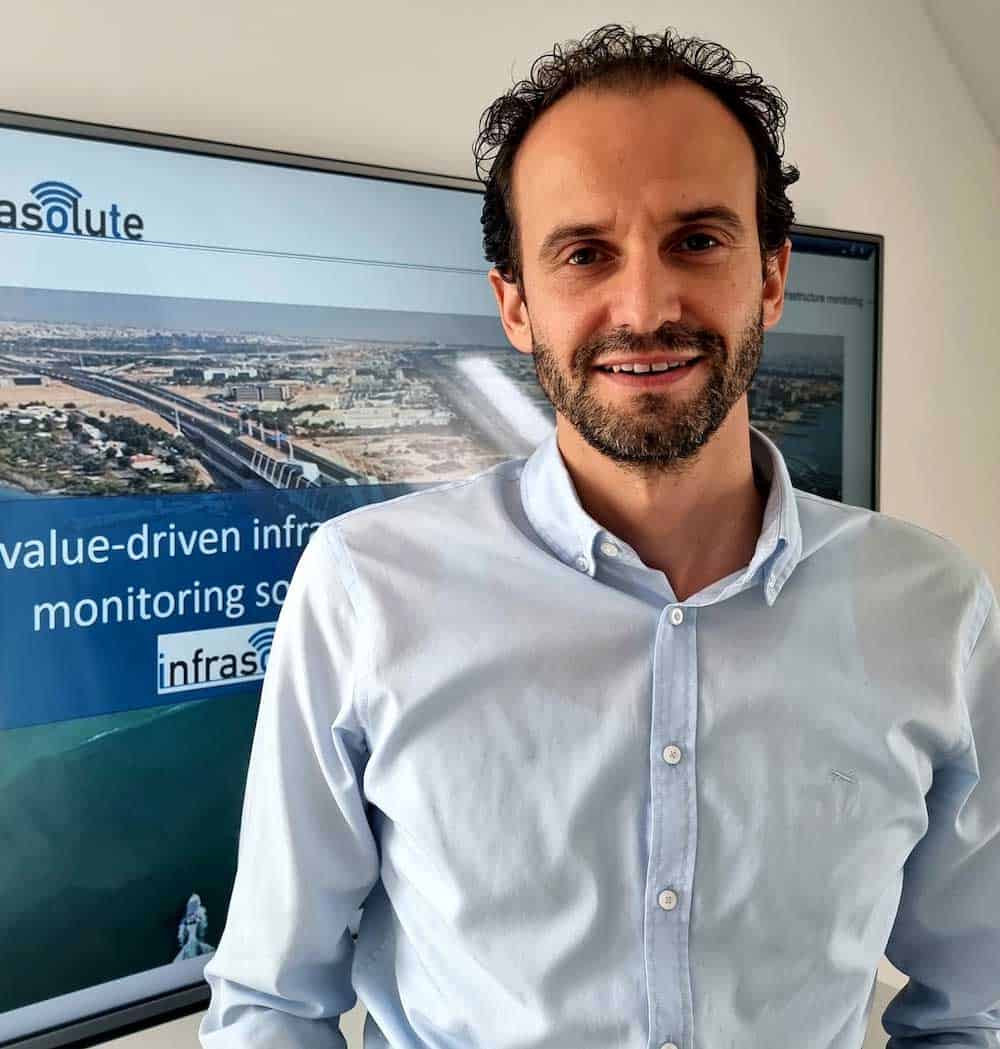
Let us advise you!
Benedikt Seuss is your personal contact and advisor in the field of intelligent concrete structures.
